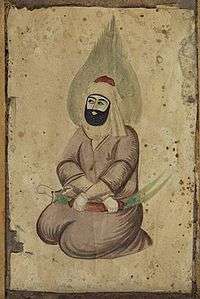Haqq–Muhammad–Ali
Haqq–Muhammad–Ali refers to a ‘trinity’ in Alevism that involves Haqq (‘Divine Truth’ referring to Allah), Muhammad and Ali.
| Haqq–Muhammad–Ali | ||
|---|---|---|
| Muhammad-Ali | HAQQ | |
| ALI | MUHAMMAD | |
| |
 |
 |
| Right: Haqq (Allāh). Center: Muḥammad (Abū al-Qāsim Muḥammad ibn ʿAbd Allāh ibn ʿAbd al-Muṭṭalib). Left: Alī ibn Abī Tālīb Markadī. | ||
The concept of "trinity" in Alevism
In Alevi thought there are three creative principles, the latent breath or Allah, the prototypal human which is made up of active and passive principles or Muhammad and the divine light expressed in Ali. Despite incorrect comparisons between Alvevism and the Christian trinity, whose three principles are called the Father, the Son and the Holy Spirit,[1] or between the trinitarian conceptions of Hinduism, with Brahma, Shiva and Vishnu, and even with polytheistic ancient Egypt with Osiris, Isis and Horus,[2][3] one cannot accurately depict such examples as being representative of Haqq–Muhammad–Ali, since according to Alevi or Bektashi beliefs (Wahdat-ul-Wujood), only Allah is a real entity, Muhammad and Ali being simple manifestations of the light(Noor) of Allah (and not of Allah himself), hence they are neither equal to it nor separate independent entities.[4][5][6]
The Alevi doctrine
Allah is divine consciousness which first creates and gives shape to the Kull-i Nafs, a latent passive energy existing within Godhead. Kull-i Nafs is actually the apparent power of God to give life form, almost like a womb in that it is a place of manifestation where the concealed potential within Allah can be known and made visible. Thus, the physical universe is a mirror image of Allah. Kull-i Nafs reflects the spirit or divine consciousness of Allah. Nafs is Arabic for breath and it is the breath that binds the spirit with Allah. Kull-i Nafs is also envisioned as the Universal Soul or Soul Body as it is the divine consciousness reflected through the breath of Allah which gives this soul its own life and forms the Universal Human, the prototypal human, made manifest in Muhammad. However, the prototypal human is not male or female, but is a perfect interplay between the two in much the same way as the Taoists envision the Taiji. Within this prototypal human active energies contain passive and passive contain active. The light or Nur which links the two together is represented by Ali.
However, most Alevis believe that the term Hak-Muhammed-Ali aşkına (for the love of God-Muhammad-Ali) has nothing to do with a trinity and is misinterpreted by outsiders. According to them it's a short way to refer to Allah as the only One to be worshipped, Muhammad as the messenger and Ali as wali or first imam of the Twelve Imams. Just like Shia Muslims Alevis say: "La ilahe ilallah, Muhammadden Resulullah, Aliyyen Veliyullah" (There is no god but God, Muhammad is His messenger, Ali is His wali).
Some Alevis have the same opinion like Quranists on this matter and believe that every prophet and saint were strictly monotheists.
Quran 18:110: Say, "I am only a man like you, to whom has been revealed that your god is one God. So whoever would hope for the meeting with his Lord - let him do righteous work and not associate in the worship of his Lord anyone."
Quran 41:6: Say, O [Muhammad], "I am only a man like you to whom it has been revealed that your god is but one God; so take a straight course to Him and seek His forgiveness." And woe to those who associate others with Allah
See also
References
- ↑ The Kurds: a concise handbook, p. 143
- ↑ The Mythological Trinity or Triad Osiris, Horus and Isis, Wikicommons
- ↑ [Manfred Lurker, Lexikon der Götter und Symbole der alten Ägypter, Scherz 1998, p. 214f
- ↑ Imaginal worlds, William Chiittick(1994), pg.53
- ↑ Souad Hakim – Unity of Being in Ibn 'Arabî
- ↑ Ibn al-'Arabi, Muhyi al-Din (1164–1240)
